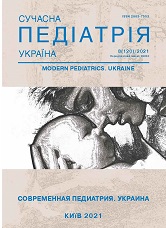Complications of diagnostics of rare congenita mitochondrial pathology — the combined deficit of the oxidizing phosphorylating 26 in a child of early age: clinical case
DOI:
https://doi.org/10.15574/SP.2021.120.62Keywords:
mitochondrial pathology, combined deficiency of oxidative phosphorylation of type 26 (COXPD-26), clinical caseAbstract
Hereditary mitochondrial diseases are a consequence of congenital errors in energy metabolism with very variable and predominantly multisystem manifestations, they require differential diagnosis with a wide range of phenotypically similar nosologies, and their verification is a complex problem with a need of a multidisciplinary approach.
The article describes a rare clinical case diagnosed in a girl of early age of a congenital mitochondrial pathology with autosomal recessive inheritance — a combined oxidative phosphorylation deficiency of type 26 (COXPD-26) due to two mutations in the heterozygous state of the TRMT5 gene (tRNA methyltransferase 5) on the chromosome 14q23. The patient's illness was accompanied by a debut from birth and was characterized by insufficient weight gain, manifestations of cardiomyopathy, repeated intercurrent infectious diseases with increased activity of blood transaminases, creatine kinase-MB, hepatopathy with hypoalbuminemia, convulsive syndrome, intolerance to valproic acid, progressive delay in stato-kinetic and psychoverbal development, that is, the symptomatology was characterized by progression, multisystem character with predominant damage to the heart, liver and nervous system.
The diagnostic algorithm for mitochondrial diseases is one of the most complex in medical practice. In young children, persistent or progressive multisystem disorder of unknown etiology, unknown multiple complex neurological manifestations or neurological monosymptom with involvement of other systems, less often — specific clinical symptoms; persistent lactic acidosis, other positive or questionable laboratory screening findings are suspicious of probable mitochondrial pathology. Numerous hospitalizations, repeated consultations by different specialists, multiple additional labtests, and multiple conflicting diagnoses may indicate a possible mitochondrial pathology. Only whole exome sequencing of a blood sample with an analysis of variations in the number of copies of genes and genomic sequencing of a new generation with targeted genetic testing made it possible to diagnose in a child a hereditary metabolic disorder from the group of defects in the mitochondrial respiratory chain — a combined deficiency of oxidative phosphorylation type 26, previously described in only a few patients.
The research was carried out in accordance with the principles of the Helsinki declaration. The informed consent of the patient was obtained for conducting the studies.
No conflict of interest was declared by the authors.
References
Chen L, Winger AJ, Knowlton AA. (2014). Mitochondrial dynamic changes in health and genetic diseases. Molecular biology reports. 41(11): 7053-7062. https://doi.org/10.1007/s11033-014-3663-y; PMid:25103020 PMCid:PMC5683169
Chi CS. (2015). Diagnostic approach in infants and children with mitochondrial diseases. Pediatrics and neonatology. 56(1): 7-18. https://doi.org/10.1016/j.pedneo.2014.03.009; PMid:25151629
Grechanina YuB, Grechanina OYa, Shkolnikova DV. (2020). Mitochondrial diseases: genetic epidemiology, diagnosis and treatment. Health of Ukraine. Pediatrics. 55; 4: 34-38.
Haas RH, Parikh S, Falk MJ, Saneto RP, Wolf NI, Darin N, Cohen BH. (2007). Mitochondrial disease: a practical approach for primary care physicians. Pediatrics. 120(6): 1326-1333. https://doi.org/10.1542/peds.2007-0391; PMid:18055683
Haller RG, Lewis SF, Estabrook RW, Di Mauro S, Servidei S, Foster DW. (1989). Exercise intolerance, lactic acidosis, and abnormal cardiopulmonary regulation in exercise associated with adult skeletal muscle cytochrome c oxidase deficiency. The Journal of clinical investigation. 84(1): 155-161. https://doi.org/10.1172/JCI114135; PMid:2544623 PMCid:PMC303965
Karimzadeh P. (2015). Approach to neurometabolic diseases from a pediatric neurological point of view. Iranian journal of child neurology. 9(1): 1-16.
Parikh S, Goldstein A, Karaa A, Koenig MK, Anselm I et al. (2017). Patient care standards for primary mitochondrial disease: a consensus statement from the Mitochondrial Medicine Society. Genetics in medicine: official journal of the American College of Medical Genetics. 19(12). https://doi.org/10.1038/gim.2017.107; PMid:28749475 PMCid:PMC7804217
Powell CA, Kopajtich R, D'Souza AR, Rorbach J, Kremer LS et al. (2015). TRMT5 Mutations Cause a Defect in Post-transcriptional Modification of Mitochondrial tRNA Associated with Multiple Respiratory-Chain Deficiencies. American journal of human genetics. 97(2): 319-328. https://doi.org/10.1016/j.ajhg.2015.06.011; PMid:26189817 PMCid:PMC4573257
Tarnopolsky MA, Brady L, Tetreault M, Care-Rare Canada Consortium (2017). TRMT5 mutations are associated with features of complex hereditary spastic paraparesis. Neurology. 89(21): 2210-2211. https://doi.org/10.1212/WNL.0000000000004657; PMid:29021354 PMCid:PMC5696640
Downloads
Published
Issue
Section
License
Copyright (c) 2022 Modern pediatrics. Ukraine

This work is licensed under a Creative Commons Attribution-NonCommercial 4.0 International License.
The policy of the Journal “MODERN PEDIATRICS. UKRAINE” is compatible with the vast majority of funders' of open access and self-archiving policies. The journal provides immediate open access route being convinced that everyone – not only scientists - can benefit from research results, and publishes articles exclusively under open access distribution, with a Creative Commons Attribution-Noncommercial 4.0 international license (СС BY-NC).
Authors transfer the copyright to the Journal “MODERN PEDIATRICS. UKRAINE” when the manuscript is accepted for publication. Authors declare that this manuscript has not been published nor is under simultaneous consideration for publication elsewhere. After publication, the articles become freely available on-line to the public.
Readers have the right to use, distribute, and reproduce articles in any medium, provided the articles and the journal are properly cited.
The use of published materials for commercial purposes is strongly prohibited.

